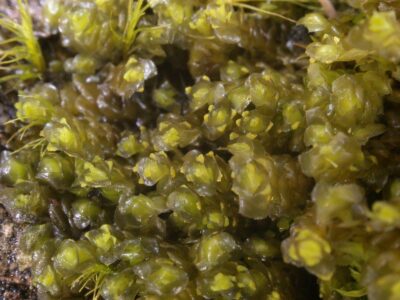
Scapania nimbosa (Cloud Earwort) is a relatively rare liverwort of cool, wet climates and a typical member of the northern hepatic mat of north-west Scotland. It is instantly recognisable in the field by the long, spinose teeth. This specimen was spotted by Gordon Rothero on Corra Bheinn during the recent BBS meeting on Jura. It was growing as scattered shoots amongst other liverwort species. You can see more photos on the Species page at https://www.britishbryologicalsociety.org.uk/learning/species-finder/scapania-nimbosa/.
View more
The paper reading session on Saturday will feature the speakers as follows: Welcome to Teesside University and the Earth, Ecology and Environment research collective. (1 min) Chris Preston will speak about the value of repeated surveys in bryology (20 mins) Jamie Bojko et al. will speak about the microbiome and viruses associated with Conocephalum conicum and […]
View more
Glyphomitrium davesii (Black-tufted moss) was a fairly frequent occurrence on the recent BBS meeting on Jura. This is an easy species to overlook unless it happens to be fruiting, which fortunately it often does! This abundantly fruiting specimen was spotted by David Long, on the side of a boulder near Glenbatrick on the west coast.
View more
Alain Vanderpoorten has a research project, entitled ‘Hiding for surviving? Last-glacial maximum phylogeography to inform spatially-explicit predictions on the ability of Alpine biota to migrate as a response to climate change in the Alps (GEN4MIG)’. For this, he would appreciate contribution of decently recent (<5-10 yrs at most) and sufficiently abundant (for DNA extraction) specimens […]
View more
The autumn meeting is getting organised, and I thought of sharing some information to help everybody prepare their trip. I am also putting together the programme for the paper reading session – the session does not have a specific theme and if you would like to present something, whether finished work, plans or bouncing some […]
View more
From a specimen collected at Merthen Wood in Cornwall on the 2022 BBS Spring Meeting. Sharon Pilkington led a couple of very successful searches along the creeks around the Helford River, where it was frequently found growing with Cephaloziella turneri (Bryophyte of the month for April) . It is quite a tricky species to photograph in the field though, thanks to its habit of growing in shady underhangs along creek banks.
View more
Calyptrochaeta apiculata (Southern Hookeria) was much admired on the BBS Spring meeting in Cornwall, March 2022. It really does look like a baby Hookeria lucens, but look more closely and you will spot the pointed leaf apex. The image above was taken by Jonathan Sleath at Frenchman's Creek, and gives some idea of the habitat on creek banks.
View more
Calling all #WomenInBryology The International Association of Bryologists are looking for contributions from women bryologists throughout the world to their project ‘Raising the profile of women in bryology’. All you need to do is write a short biography saying where you come from, how you came to study bryophytes and why you enjoy bryology. Biographies […]
View more
This microscope image of a shoot and perianth of Cephaloziella turneri (Turner's Threadwort) was taken from a specimen collected on the BBS Spring Meeting in Cornwall, 2022. Several populations were found in creeks along the Helford River, but this one was actually growing inland on a private estate near Bodmin. (Click below for the full image).
View more
You may remember that last year, a team from the US studying Physcomitrium pyriforme requested specimens from Europe to assist in their studies (you can read the post here). The team are still short of European samples, and have just circulated the following request on Bryonet: Given the restrictions imposed by the pandemic, our ability to […]
View more